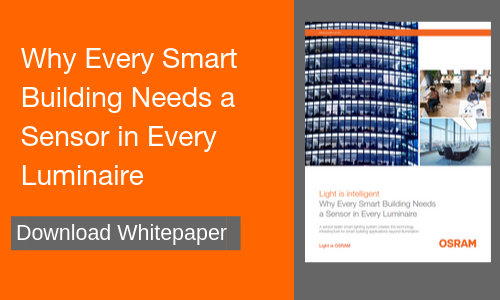New Indoor Positioning and Proximity Applications Use Bluetooth Beacons
![]() The latest beacon technology is enabling new applications in healthcare, higher-ed, and commercial real estate.
The latest beacon technology is enabling new applications in healthcare, higher-ed, and commercial real estate.
Most of us have used a GPS (Global Positioning System) to navigate, by car or foot, to new outdoor places. Although GPS works in any weather conditions, anywhere in the world, 24 hours a day, it does not work well for indoor navigation applications. Roofs, walls, and other objects scatter signals from satellites, and navigating the error range can be larger than the total indoor space. Bluetooth® beacons are similar in concept to GPS but are applicable for indoor applications because they offer higher accuracy with a signal range of 10 – 30 meters. According to Research and Markets, the global beacon technology market stood at $1.17 billion in 2018 and is projected to grow at a CAGR of 45.5% during 2019-2024 to reach $10.2 billion by 2024.
Multiple Bluetooth beacons generate signals containing a small amount of data and are transmitted to nearby compatible Bluetooth-enabled mobile devices, to accurately pinpoint the location of a person or asset inside of a building. Initial implementations of this technology focused on push notifications such as marketing offers or breaking news to installed mobile app recipients, but today the technology has evolved and is also used for sophisticated indoor positioning or navigation systems. In an indoor positioning system, Bluetooth beacon data generates accurate coordinates of an individual’s location with an accuracy of 1-2 meters. This information is then displayed on the indoor mapping application on their smartphone to guide them through the building, similar to the way a GPS helps navigate someone driving or walking to an outdoor location.
Enhance the In-store Retail Experience
Retailers have had initial success using beacons to attract consumer attention and provide a more dynamic and personalized in-store experience. For example, when a beacon detects consumers entering a store, a push notification is sent to their smart device that pants are on sale from a brand that they have previously purchased. Similarly, they might receive a notice that a specific shirt and tie would go perfectly with the suit they recently bought from their store. Coupons or rewards are also served up to shoppers to offer incentives to buy certain products, thus boosting the shopping experience. The personalization consumers receive online can now be brought to the brick-and-mortar store.
More advanced indoor positioning programs using Bluetooth beacons help consumers navigate within the store to a product category and find the exact product they seek. They can also help retailers target shoppers with products located in the same aisle or area of the store.
Improve Asset Tracking and Staff Productivity in Healthcare
Healthcare facilities are continually investing in the latest diagnostic and patient care equipment, and these assets are moved frequently from one location to another to service the patient easily. Bluetooth beacons enable the tracking of portable imaging machines and wheelchairs, for example, so that staff can quickly find these assets where and when needed.
Patients and visitors also leverage beacon technology in hospitals and other medical care facilities for wayfinding. By downloading an indoor map of a facility or complex to their mobile phone, they can navigate to their destination within the facility without getting lost and needing to ask staff members for directions. Beacon-based digital wayfinding can ease the burden on hospital staff of people stopping them for directions, while also increasing the number of on-time appointments.
Boost Security and Helping Manage College Campus Growth
The opportunity for Bluetooth beacons on a college campus is abundant. Indoor positioning systems help students, staff, and visitors navigate the campus, whether attending a lecture or sporting event. New students and their parents can acclimate to the campus and college life more quickly. Also, the data gathered through beacons can boost campus safety programs using campus alert systems, including geo-location targeted messages or across the university.
Optimize Commercial Office Space Utilization
In commercial office space, beacons can provide real-time visibility into the occupancy of different types of workspaces and areas within a building. Overly congested or underutilized areas can be modified so that space is better utilized. For example, beacon data might indicate that some regularly occupied desks are close to a high traffic area, yet there is an underutilized space away from traffic that might be a more suitable location for this group of desks.
In many real-life situations, emergency personnel often arrive on the scene and do not know where individuals requiring assistance are located. Bluetooth beacons can quickly indicate via map-based visualization what areas of a building are occupied during an emergency. This information can help emergency personnel develop an optimal plan of action.
Bluetooth beacon-based digital wayfinding can assist employees and visitors as they navigate a commercial office or campus to find an available desk, specific conference room, or staff location. This feature is particularly useful for large or growing organizations that optimize office space on an ongoing basis, and regularly move employees within the space or modify conference room locations.
Beacon Technology Location
Beacons work best when they are placed on ceilings or high on walls because physical objects such as desks, walls, or even people can interfere with signal strength. Consequently, for high accuracy signaling, a good location for a beacon is within a luminaire or tethered to a luminaire. Additionally, the beacon can directly connect to a reliable power source via the LED driver AUX within the luminaire eliminating the need for batteries, which degrade beacon performance over time and require replacement due to their limited life.
The latest technologies are now integrated in luminaires and lighting systems to enable smart building applications beyond smart lighting. Download our white paper Why Every Smart Building Needs a Sensor in Every Luminaire to learn more.
Topics: Connected Lighting & IoT

.png)
